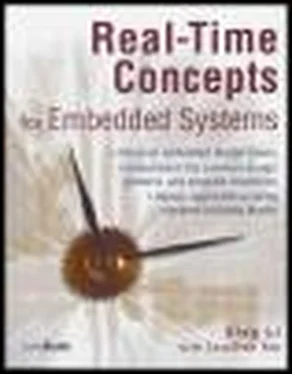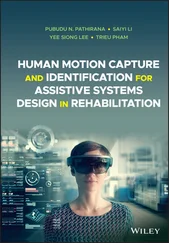Qing Li and Carolyn Yao
Real-Time Concepts for Embedded Systems
We live in a world today in which software plays a critical part. The most critical soft ware is not running on large systems and PCs. Rather, it runs inside the infrastructure and in the devices that we use every day. Our transportation, communications, and energy systems won't work if the embedded software contained in our cars, phones, routers and power plants crashes.
The design of this invisible, embedded software is crucial to all of us. Yet, there has been a real shortage of good information as to effective design and implementation practices specific to this very different world. Make no mistake, it is indeed different and often more difficult to design embedded software than more traditional programs. Time, and the interaction of multiple tasks in real-time, must be managed. Seemingly esoteric concepts, such as priority inversion, can become concrete in a hurry when they bring a device to its knees. Efficiency-a small memory footprint and the ability to run on lower cost hardware-become key design considerations because they directly affect cost, power usage, size, and battery life. Of course, reliability is paramount when so much is at stake-company and product reputations, critical infrastructure functions, and, some times, even lives.
Mr. Li has done a marvelous job of pulling together the relevant information. He lays out the issues, the decision and design process, and the available tools and methods. The latter part of the book provides valuable insights and practical experiences in understanding application development, common design problems, and solutions. The book will be helpful to anyone embarking on an embedded design project, but will be of par ticular help to engineers who are experienced in software development but not yet in real-time and embedded software development. It is also a wonderful text or reference volume for academic use.
The quality of the pervasive, invisible software surrounding us will determine much about the world being created today. This book will have a positive effect on that quality and is a welcome addition to the engineering bookshelf.
Chairman and Co-Founder, Wind River
Embedded systems are omnipresent and play significant roles in modern-day life. Embed ded systems are also diverse and can be found in consumer electronics, such as digital cameras, DVD players and printers; in industrial robots; in advanced avionics, such as missile guidance systems and flight control systems; in medical equipment, such as cardiac arrhythmia monitors and cardiac pacemakers; in automotive designs, such as fuel injection systems and auto-braking systems. Embedded systems have significantly improved the way we live today-and will continue to change the way we live tomorrow.
Programming embedded systems is a special discipline, and demands that embedded sys tems developers have working knowledge of a multitude of technology areas. These areas range from low-level hardware devices, compiler technology, and debugging tech niques, to the inner workings of real-time operating systems and multithreaded applica tion design. These requirements can be overwhelming to programmers new to the embedded world. The learning process can be long and stressful. As such, I felt com pelled to share my knowledge and experiences through practical discussions and illustrations in jumpstarting your embedded systems projects.
Some books use a more traditional approach, focusing solely on programming low-level drivers and software that control the underlying hardware devices. Other books provide a high-level abstract approach using object-oriented methodologies and modeling lan guages. This book, however, concentrates on bridging the gap between the higher-level abstract modeling concepts and the lower-level fundamental programming aspects of embedded systems development. The discussions carried throughout this book are based on years of experience gained from design and implementation of commercial embedded systems, lessons learnt from previous mistakes, wisdom passed down from others, and results obtained from academic research. These elements join together to form useful insights, guidelines, and recommendations that you can actually use in your real-time embedded systems projects.
This book provides a solid understanding of real-time embedded systems with detailed practical examples and industry knowledge on key concepts, design issues, and solu tions. This book supplies a rich set of ready-to-use embedded design building blocks that can accelerate your development efforts and increase your productivity.
I hope that Real-Time Concepts for Embedded Systems will become a key reference for you as you embark upon your development endeavors.
If you would like to sign up for e-mail news updates, please send a blank e-mail to: #mailto:rtconcepts@news.cmpbooks.com. If you have a suggestion, correction, or addition to make to the book, e-mail me at #mailto:qingli@speakeasy.net.
This book is oriented primarily toward junior to intermediate software developers work ing in the realm of embedded computing.
If you are an experienced developer but new to real-time embedded systems develop ment, you will also find the approach to design in this book quite useful. If you are a technical manager who is active in software design reviews of real-time systems, you can refer to this book to become better informed regarding the design and implementation phases. This book can also be used as complementary reference material if you are an engineering or computer science student .
Before using this book, you should be proficient in at least one programming language and should have some exposure to the software-development process.
We would like to thank the team at CMP Books and especially Paul Temme, Michelle O'Neal, Marc Briand, Brandy Ernzen, and Robert Ward.
We wish to express our thanks to the reviewers Jerry Krasner, Shin Miyakawa, Jun-ichiro itojun Hagino, and Liliana Britvic for their contributions.
We would like to thank Nauman Arshad for his initial participation on this project.
We would also like to thank Anne-Marie Eileraas, Salvatore LiRosi, Loren Shade, and numerous other individuals at Wind River for their support.
Finally, thanks go to our individual families for their love and support, Huaying and Jane Lee, Maya and William Yao.
In ways virtually unimaginable just a few decades ago, embedded systems are reshaping the way people live, work, and play. Embedded systems come in an endless variety of types, each exhibiting unique characteristics. For example, most vehicles driven today embed intelligent computer chips that perform value-added tasks, which make the vehicles easier, cleaner, and more fun to drive. Telephone systems rely on multiple integrated hardware and software systems to connect people around the world. Even private homes are being filled with intelligent appliances and integrated systems built around embedded systems, which facilitate and enhance everyday life.
Often referred to as pervasive or ubiquitous computers, embedded systems represent a class of dedicated computer systems designed for specific purposes. Many of these embedded systems are reliable and predictable. The devices that embed them are convenient, user-friendly, and dependable.
One special class of embedded systems is distinguished from the rest by its requirement to respond to external events in real time. This category is classified as the real-time embedded system .
Читать дальше












